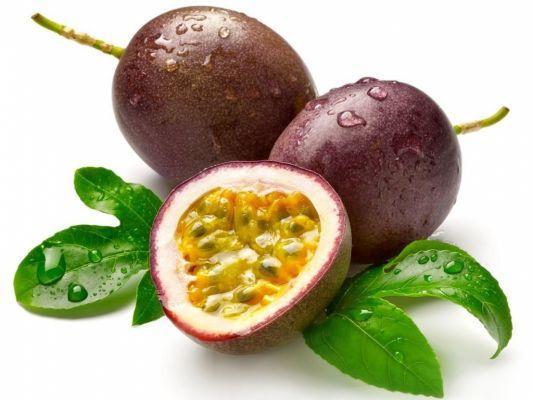
Il passion fruit is originally from Brazil, where it is also known as Passion fruit. It contributes to good heart and intestine health and to the beauty of the skin. Let's find out better.
- Passion fruit description
- Properties of the passion fruit
- Calories and nutritional values of passion fruit
- Ally of
- Curiosity
- A recipe with passion fruit
Passion fruit description
Passion fruit or passion fruit is a tropical fruit native of Brazil, which belongs to the genus Passiflora. There are several species, but the best known are there passion fruit viola and yellow passion fruit.
Has a very intense perfume, a sweet-sour taste and an oval or rounded shape, of medium or small cut, depending on the quality; in fact, the yellow passion fruit has larger dimensions than the purple passion fruit.
Passion fruit peel is not edible, so yes it can only consume the pulp. The seeds, on the other hand, are usually used for animal feed and foroil extraction.
Properties of the passion fruit
Passion fruit is a concentrate of valuable nutrients which give it numerous beneficial properties. Between these:
- Antioxidant: the high content of antioxidant molecules such as vitamin C, beta-carotene and polyphenols, make it useful in preventing chronic diseases such as tumors, type 2 diabetes and neurodegenerative diseases.
- Anti-inflammatory: rich in antioxidants (especially in the peel), it has a high anti-inflammatory power, useful in combating disorders and diseases related to inflammation, such as osteoarthritis.
- Promotes intestinal health: rich in fiber, it promotes intestinal transit and the functionality of the microbiota.
- Check your blood sugar and cholesterol levels: thanks to the presence of soluble fibers, it is able to reduce the speed of absorption of sugars and fats.
Calories and nutritional values of passion fruit
100 g of passion fruit provide:
97 kcal
2,2 g protein
0,7 g fat
G carbohydrates 23,3
Sugars 11,2 g
Fiber 10,4 g
Ally of
Skin, heart and intestines.
Read also Passion fruit, a help against diabetes
Interesting facts about the passion fruit
The name passion fruit originates from flower shape, whose elements recall the Passion and the crucifixion of Jesus: the corolla, in fact, recalls a crown of thorns, while the pistils recall the nails of the crucifixion.
Passion flower species and their fruits
A recipe up your sleeve
Passion fruit can be consumed in purity or used as an ingredient in jams, creams and drinks. Have you ever tried making a sorbet with passion fruit? Here is the recipe!
Ingredients
- 400 gr of passion fruit;
- 250 ml of water;
- 120 grams of whole cane sugar;
- juice of 1 lemon.
Preparation
After cleaning the passion fruits, pass everything through a colander to extract pulp and juice. Add 100 ml of water and the juice of one lemon. Pour the sugar and the rest of the water into a saucepan and bring to a boil. Add the fruit mixture, remove from heat and mix everything well.
Allow the mixture to cool, first at room temperature and then in the freezer for two hours. Take the mixture out of the freezer, mix it with a spoon and put it back in the freezer for another 6 hours. After 6 hours, the passion fruit sorbet will be ready to be tasted.
Also find out how passionflower is grown
Bibliography and sources
Prospective study of carotenoids, tocopherols, and retinoid concentrations and the risk of breast cancer, Cancer Epidemiology, Biomarkers & Prevention
Free radicals, antioxidants and functional foods: Impact on human health, Pharmacognosy Reviews
Fiber and prebiotics: mechanisms and health benefits, Nutrients
Benefits of antioxidant supplements for knee osteoarthritis: rationale and reality, Nutrition Journal
FoodData Central, U.S. DEPARTMENT OF AGRICULTURE


























